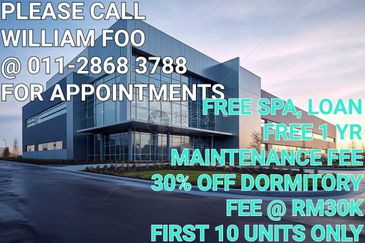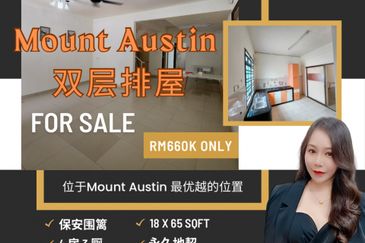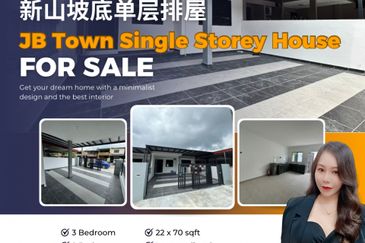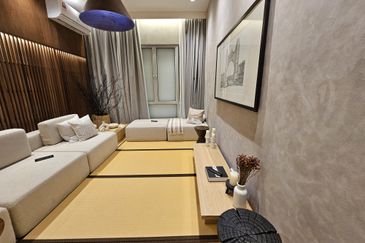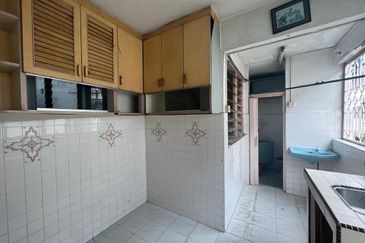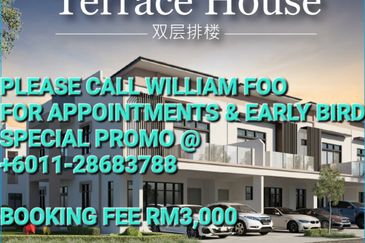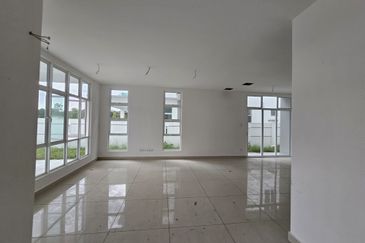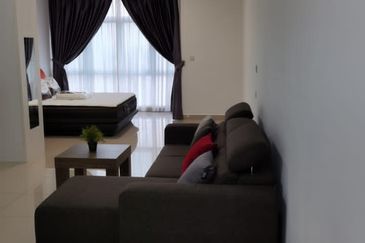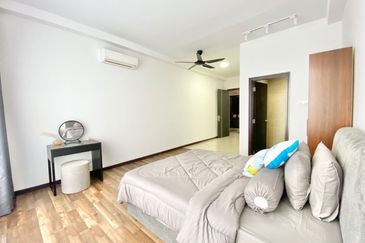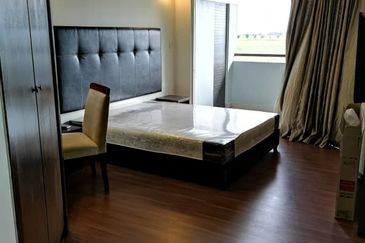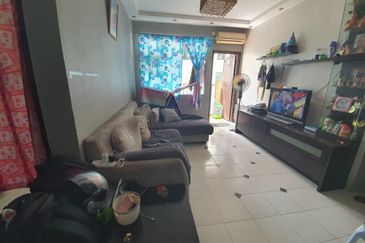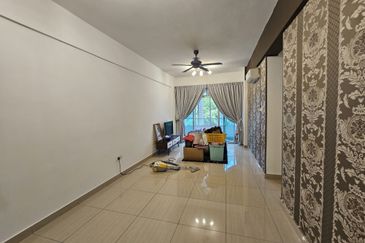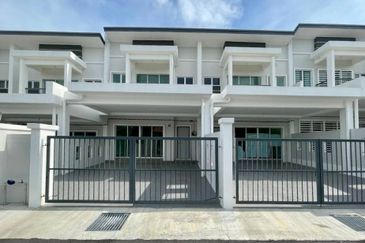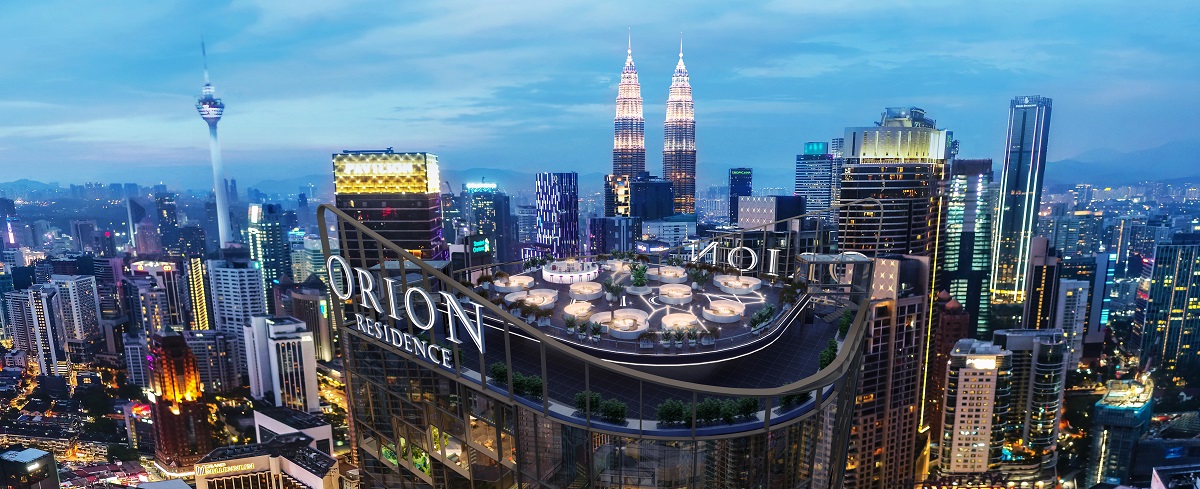 It was just a month ago that we met up with Datuk Abdul Wahab Maskan, COO of Sime Darby Bhd and managing director of Sime Darby Property Bhd (SDP), for an interview. Abdul Wahab was group chief executive of Kumpulan Guthrie Bhd and Golden Hope Plantations Bhd before the two companies merged with Sime Darby and Negara Properties (M) Bhd in 2007.
It was just a month ago that we met up with Datuk Abdul Wahab Maskan, COO of Sime Darby Bhd and managing director of Sime Darby Property Bhd (SDP), for an interview. Abdul Wahab was group chief executive of Kumpulan Guthrie Bhd and Golden Hope Plantations Bhd before the two companies merged with Sime Darby and Negara Properties (M) Bhd in 2007.
As he was away on business this time around, the interview was conducted via email.
During the interview in early August, Abdul Wahab appeared calm, chatting with his team and commenting: “I want them to sit and know that it isn’t easy answering all these questions posed by the media. Next time, they can do it.”
As SDP enters an aggressive mode, he cites the need to “train its people well and retain the right talent”. The developer is hiring to add to its current team of about 1,500 people.
“We want to internationalise our team in the way we do things as well as our products. It is one of the strategies and challenges we are facing. This can only be done by recruiting and investing in people,” he adds.
SDP, already known for its township developments Subang Jaya and Ara Damansara, is poised to make great strides in the industry and is moving on to its next growth strategy. It plans to launch some RM2 billion worth of properties from now until the end of FY2012.
“We have to plan a new enhanced set of strategies or objectives to take us to a higher level. We want higher profits and our target is that by 2016, we want the property division to be among the billion-ringgit achievers in terms of profit. We have the potential to do so as we have the resources, assets, brand, balance sheet and capability,” he points out. Property development will remain the core (80%), supported by property investment/management.
“The bulk of our projects will be in Malaysia and Singapore. We hope to strengthen our position overseas as well, especially in China, as we believe it has huge business potential.”
Read on for Abdul Wahab’s take on the property market and more on SDP’s upcoming projects and future strategies.
The Edge: Are you on target to launch RM2 billion worth of projects until FY2012?
Datuk Abdul Wahab Maskan: We are on track. From July to now, we have successfully launched Maple Terrace, our 3-storey link homes in Denai Alam, as well as Avalon, our bungalows in USJ Heights, and Davina III & Iluna in Nilai Impian. These properties are collectively worth more than RM320 million.
In addition, we will soon be launching Isola, a 216-unit serviced condominium in Subang Jaya with a GDV of above RM240 million. More launches are in the pipeline, such as condovillas in Ara Damansara and more link houses in Nilai Impian, Denai Alam and Bandar Bukit Raja in 4Q2011.
We are also on target to launch Quarza Residen serviced apartments and a new condominium project in Melawati in 2Q2012. This RM2 billion target is higher than last year’s. We continue to raise the bar to keep growing the business and turnover as well as to keep our leadership position as a property developer in quantitative terms.
Your take on the current property market and the challenges in the near future?
We are cautiously optimistic about Malaysia’s property market, especially in our area of operations. We expect the resilient Malaysian economy and continued consumer confidence to sustain the positive momentum, especially for residential and commercial properties located in strategic areas where we operate.
Malaysian consumers have become more discerning when it comes to buying properties. Developers must be able to deliver functional and quality products with differentiation elements.
We guarantee delivery and will give best value for money. We also emphasise building sustainable and innovative homes, properties and built environments for the consumer.
How do you see the property market in the next 12 months?
It is generally expected to remain positive but cautious in certain subsectors. The residential property market is expected to remain positive this year, especially in such growth areas as the Klang Valley, Greater KL and other urban centres. Home prices are expected to be on an uptrend in 2H2011, especially for the new launches due to anticipated higher cost of construction and land. Improved accessibility due to the MRT project and other infrastructure will also cause prices in selected areas to rise.
You mentioned wanting to ‘internationalise the team in the way we do things as well as our products’. What are your plans to achieve this?
Internationalising the SDP team has basically two meanings:
• Having human capital with a work culture and mindset geared towards delivering performance that is benchmarked against international best practices and value proposition; and
• Having an organisation with international class governance and operational infrastructure, and systems that support maximum performance of human capital, providing innovative and attractive products and services.
To achieve this, we have to invest in time and effort to train and retain the right talent and importantly, we should draw from a global talent pool, tapping the best and brightest regardless of nationality or background.
As far as our products are concerned, what it means is to look and learn from some of the best projects abroad. Learn, apply, adapt or improve, where applicable, the design, construction methods and even procurement process with the objective of delivering better products and services to our customers. We should use international collaboration to create liveable, sustainable, safe and memorable communities and products that are well designed and on a par with or better than the best.
What do you think are some of SDP’s strengths as a property developer? Some people say it is only strong in size (financially and landbank) but there is a need for improvement in terms of quality. What do you have to say?
On the contrary, quality has become a selling point for the SDP brand. This is a result of our commitment to high standards.
SDP was the first property developer in Malaysia to be awarded four ISO management system certification, namely ISO 9001 (Quality Management System), ISO14001 (Environmental Management System), OHSAS 18001 and MS1722 (Safety and Health Management System). We have also put in place initiatives ranging from contractor performance monitor to advanced customer relations management programmes to enhance the quality of our products and services.
 As a brand, SDP has garnered a reputation for being a builder of successful and sustainable townships. Our track record spans decades and as such, we are a developer that has been and will continue to be around for a long time. Our products are also known to be innovative and value-creating in terms of appreciation for property owners and investors.
As a brand, SDP has garnered a reputation for being a builder of successful and sustainable townships. Our track record spans decades and as such, we are a developer that has been and will continue to be around for a long time. Our products are also known to be innovative and value-creating in terms of appreciation for property owners and investors.
The strength of our brand and track record has been recognised by our peers in the industry. We have been ranked Malaysia’s No 1 property developer by The Edge Top Property Developers Awards 2009. We also won the Most Valuable Brands Awards in the property and infrastructure industry category in 2007, 2008 and 2009. In March 2011, SDP was the gold winner of the prestigious Putra Brand Awards 2011 in the property development category. SDP was also the 2010 Malaysia Frost & Sullivan Green Builder of the Year and won BCI Asia Top 10 Developers Awards 2011. We were also awarded the Reader’s Digest Most Trusted Brand for 2011.
What are some of SDP’s efforts to improve its products and image as a developer?
As the leader in building sustainable communities, we have incorporated the tenets of sustainability into our corporate DNA. We also have to continuously push back the boundaries in terms of innovating and applying these innovations in a pragmatic manner in our offerings.
We are probably the only developer that has a dedicated R&D and innovation department that reports directly to management. Apart from continuously improving product development, new approaches have been introduced, such as the development of the Sime Darby Idea House, the first carbon neutral residence in Southeast Asia. Some of the knowledge and innovation developed from the Idea House has been progressively incorporated into our new offerings, including our recently launched Ficus Peak homes in Denai Alam.
As a developer that is serious about pushing the sustainability agenda, we adopt a holistic urban design approach to creating sustainable communities and built environments, starting at site identification, township master planning, landscape and open space design to detailed architectural product design, good community lifestyle and safe environment. The vision and concept of a new community must be carried rigorously through from inception to completion and through well-established maintenance programmes. At SDP, creating high quality and well-designed products that are responsible and environmentally responsive to the site; climate, context and culture is a given [criteria]. Additionally, we want to create product designs that are timeless and withstand the changing styles and trends — a hallmark of the SDP brand that purchasers and users know will be ensured of — quality, comfort and value for money when they purchase SDP homes and properties or live in our communities.
Affordable housing is a hot topic now. Will we see more developers focusing on affordable housing versus high-end properties now? What about SDP?
SDP sees affordable homes as properties that are resilient and cater for the majority of consumers. Affordable price is relative and for now is below RM500,000. We already have in the pipeline a strong supply of these properties in the current financial year as well as the following years. This component is a substantial content of our townships.
I believe there will be many developers supporting the initiative to provide affordable homes. It has also been well received by the property market, specifically the middle-income segment that wants to own property of its own and have a better quality of life.
Our affordable housing strategy and programmes fit in with the market and can contribute to the government’s efforts to build quality affordable housing through PR1MA. We have identified a few areas in our townships for this programme, such as Ara Damansara, Bandar Bukit Raja and Putra Heights, and upcoming projects slated for Kota Elmina, Elmina West and Lagong Mas in Selangor and Bandar Ainsdale in Seremban, Negeri Sembilan.
In Bandar Ainsdale, a 550-acre township in Seremban, we plan to build 2,220 affordable homes under this programme commencing at the end of this year.
What are the lessons learnt as a property developer that has been in the industry for so long? How does a developer sustain its business and consumer interest in its products?
SDP has been around for 40 years. We have built more than 50,000 homes. We have projects like Subang Jaya,Bukit Jelutong, Ara Damansara and Oasis Square, to name but a few. Developing self-sufficient townships with all the amenities and facilities for customers from all walks of life (from low to high-income segments) has enabled us to have a deep understanding of the intricacies of township development. We believe that a developer must continuously adapt to changes and improve in terms of product and service quality to remain viable and grow. Complacency has no place in the mindset of an internationally inspired brand like SDP.
How sustainable is SDP’s sustainable development agenda?
Sustainability is our way forward. It is very much a part of the Sime Darby Group’s corporate mission. SDP will continue to play a significant role in championing the sustainable agenda and setting new trends through our R&D initiative in our effort to make the company a dynamic brand.
All architecture as well as built environments must be sustainable. Sustainability is not a trend or a catch phrase but the responsibility of a leading developer and we take this responsibility very seriously.
Sustainability is inherent in every design approach and development decision that we make. Yes, we have been asked why we place so much emphasis on this and why we spend a lot of money on it. We believe sustainability has a bigger meaning — it is the philosophy of doing business.
Sustainability can create value. We take it that we invest in the environment to take care of our future — future income as well as future generations.
For example, our products are designed to be environmentally responsive, sustainable and responsible so that there is minimal impact on the site and context. The products enjoy maximum cross-ventilation, natural daylight and reduced dependence on artificial air-conditioning and lighting, which result in high operational and maintenance costs.
We have successfully launched products that emanate from innovative ideas and elements from the Sime Darby Idea House. Having said that, this is not limited to technology.
From the Idea House, we have learnt how to design spaces more efficiently and by doing so we are able to improve the building methods. We had a deeper insight into how our customers live and clearly understand the changing trends in lifestyle. For example, as our townships grow and communities begin to form further away from the Klang Valley, communication becomes a critical need in the absence of efficient physical mobility. That is why we are building the infrastructure to allow our customers to become more connected.
Ficus Peak, our recent launch in Denai Alam, comes pre-equipped with home network solutions and broadband services. In addition, we have been looking very closely at the way materials are chosen and that is where we are sensitive to the recyclability of the materials that we choose.
Moving forward, we have a lot of exciting ideas that will make us rethink what the idea of a house is and that includes customisation and expandability. The idea relates to sustainability strongly and forces us to rethink how we utilise our resources.
For example, why buy a 3-bedroom house where there are only three people in the family? Why can’t we expand the house in the future with minimal fuss and construction complications?
These are the questions that keep us looking at innovation creatively in order to meet our customers’ needs and to ensure that it is sustainable.
This article appeared in City & Country, the property pullout of The Edge Malaysia, Issue 878, Oct 3-9, 2011
TOP PICKS BY EDGEPROP

D'Carlton Seaview Residences (Seri Mega)
Masai, Johor
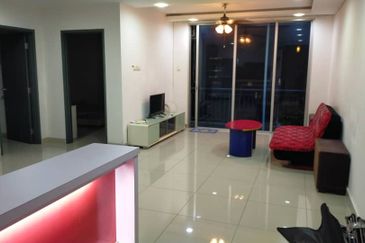
D'Ambience Residences (Ikatan Flora), Bandar Baru Permas Jaya
Permas Jaya/Senibong, Johor

Apartment Tanjung Puteri Resort
Pasir Gudang, Johor

D'Carlton Seaview Residences (Seri Mega)
Masai, Johor


